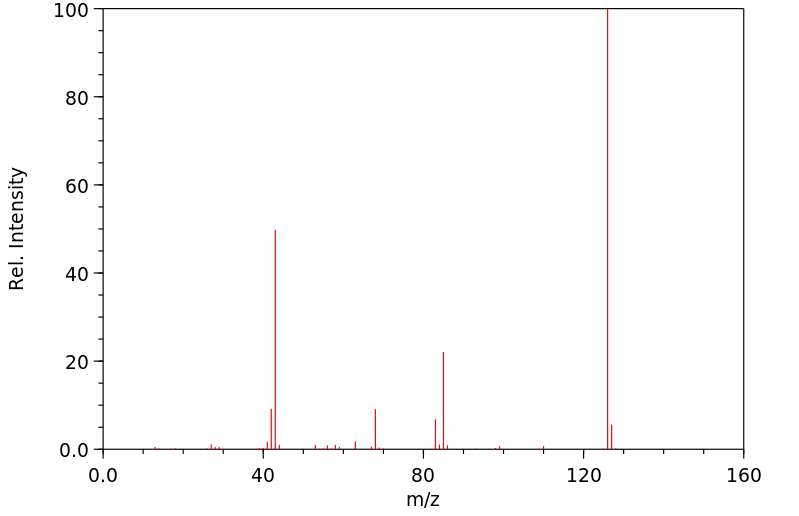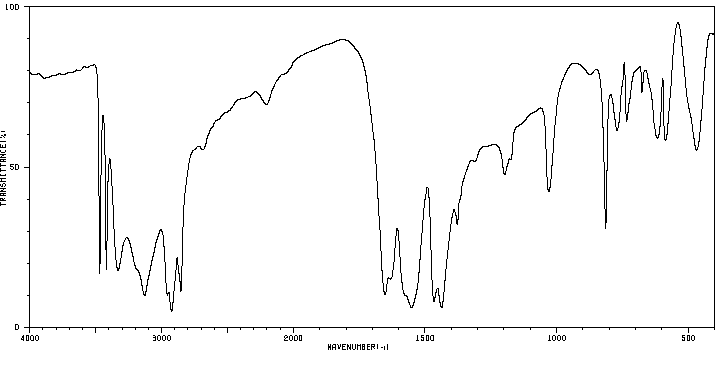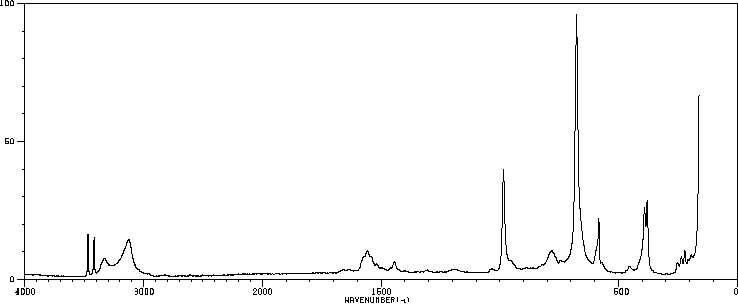三聚氰胺 | 108-78-1
-
物化性质
-
计算性质
-
ADMET
-
安全信息
-
SDS
-
制备方法与用途
-
上下游信息
-
文献信息
-
表征谱图
-
同类化合物
-
相关功能分类
-
相关结构分类
物化性质
-
熔点:>300 °C (lit.)
-
沸点:224.22°C (rough estimate)
-
密度:1.573
-
闪点:>110°C
-
溶解度:水中的溶解度:25mg/mL,清澈至微浑浊,无色
-
LogP:-1.22 at 20℃
-
物理描述:Melamine appears as colorless to white monoclinic crystals or prisms or white powder. Sublimes when gently heated. (NTP, 1992)
-
颜色/状态:Monoclinic prisms
-
蒸汽密度:4.34 (NTP, 1992) (Relative to Air)
-
蒸汽压力:3.59X10-10 mm Hg at 20 °C (extrapolated)
-
亨利常数:Henry's Law constant = 1.84X10-14 atm-cu m/mol at 25 °C (est)
-
自燃温度:>500 °C
-
分解:DANGEROUS; WHEN HEATED TO DECOMP, EMITS HIGHLY TOXIC FUMES OF /NITROGEN OXIDES AND HYDROGEN CYANIDE/.
-
燃烧热:-1967 kJ/mol at 25 °C
-
折光率:Index of refraction: 1.872 at 20 degC/D
-
解离常数:pKa = 5.0
-
保留指数:1538
-
稳定性/保质期:
计算性质
-
辛醇/水分配系数(LogP):-1.4
-
重原子数:9
-
可旋转键数:0
-
环数:1.0
-
sp3杂化的碳原子比例:0.0
-
拓扑面积:117
-
氢给体数:3
-
氢受体数:6
ADMET
安全信息
-
TSCA:Yes
-
危险品标志:Xn
-
安全说明:S36/37
-
危险类别码:R44,R20/21
-
WGK Germany:1
-
海关编码:2933610000
-
危险品运输编号:3263
-
RTECS号:OS0700000
-
包装等级:III
-
危险性防范说明:P201,P202,P280,P308+P313,P405,P501
-
危险性描述:H361
-
储存条件:1. 储存于阴凉、通风的库房。远离火种和热源。应与氧化剂、酸类分开存放,切忌混储。储区需备有合适的材料以收容泄漏物。 2. 包装使用塑料袋外套聚丙烯编织袋或麻袋或牛皮纸袋或涂胶玻璃丝袋,每袋装25kg或40kg。应贮存在阴凉、干燥、通风的地方。需要注意防晒、防热和防潮,严禁在高温下进行储存和运输。
SDS
| 第一部分:化学品名称 |
| 化学品中文名称: | 三聚氰胺;2,4,6-三氨基均三嗪 |
| 化学品英文名称: | Melamine;2,4,6-Triamino symtriazine |
| 中文俗名或商品名: | |
| Synonyms: | |
| CAS No.: | 108-78-1 |
| 分子式: | C 3 H 6 N 6 |
| 分子量: | 126.12 |
| 第二部分:成分/组成信息 |
| 纯化学品 混合物 | ||||||
| 化学品名称:三聚氰胺;2,4,6-三氨基均三嗪 | ||||||
|
| 第三部分:危险性概述 |
| 危险性类别: | |
| 侵入途径: | 吸入 食入 |
| 健康危害: | 接触者可发生皮炎。未见职业中毒报道。注意,本品在高温下能分解产生高毒的氰化物气体。 |
| 环境危害: | |
| 燃爆危险: | 本品不燃。 |
| 第四部分:急救措施 |
| 皮肤接触: | 脱去污染的衣着,立即用肥皂水及流动清水冲洗受污染的皮肤。 |
| 眼睛接触: | 立即翻开上下眼睑,用流动清水冲洗,至少15分钟。就医。 |
| 吸入: | 脱离现场至空气新鲜处。就医。 |
| 食入: | 误服者漱口,用1:5000的高锰酸钾或5%硫代硫酸钠洗胃。就医。 |
| 第五部分:消防措施 |
| 危险特性: | 受热分解放出剧毒的氰化物气体。 |
| 有害燃烧产物: | 一氧化碳、二氧化碳、氮氧化物、氰化氢。 |
| 灭火方法及灭火剂: | 雾状水、泡沫、二氧化碳、干粉、砂土。 |
| 消防员的个体防护: | 消防人员必须佩戴过滤式防毒面具(全面罩)或隔离式呼吸器、穿全身防火防毒服,在上风向灭火 |
| 禁止使用的灭火剂: | |
| 闪点(℃): | 无意义 |
| 自燃温度(℃): | 无意义 |
| 爆炸下限[%(V/V)]: | 无意义 |
| 爆炸上限[%(V/V)]: | 无意义 |
| 最小点火能(mJ): | |
| 爆燃点: | |
| 爆速: | |
| 最大燃爆压力(MPa): | |
| 建规火险分级: |
| 第六部分:泄漏应急处理 |
| 应急处理: | 戴好防毒面具,穿化学防护服。使用无火花工具收集运到空旷处焚烧。如大量泄漏,收集回收或无害处理后废弃。 |
| 第七部分:操作处置与储存 |
| 操作注意事项: | 密闭操作,全面排风。操作人员必须经过专门培训,严格遵守操作规程。建议操作人员佩戴自吸过滤式防尘口罩,戴化学安全防护眼镜,穿防毒物渗透工作服,戴橡胶手套。避免产生粉尘。避免与氧化剂、酸类接触。搬运时要轻装轻卸,防止包装及容器损坏。配备泄漏应急处理设备。倒空的容器可能残留有害物。 |
| 储存注意事项: | 储存于阴凉、通风的库房。远离火种、热源。应与氧化剂、酸类分开存放,切忌混储。储区应备有合适的材料收容泄漏物。 |
| 第八部分:接触控制/个体防护 |
| 最高容许浓度: | 中国MAC:未制订标准前苏联MAC:0.5mg/m3 美国TLV—TWA:未制订标准美国T |
| 监测方法: | |
| 工程控制: | 密闭操作,全面排风。 |
| 呼吸系统防护: | 空气中浓度超标时,应该佩戴防毒面具。 |
| 眼睛防护: | 可采用安全面罩。 |
| 身体防护: | 穿工作服。 |
| 手防护: | 必要时戴防化学品手套。 |
| 其他防护: | 工作现场禁止吸烟、进食和饮水。工作后,彻底清洗。 |
| 第九部分:理化特性 |
| 外观与性状: | 白色、单斜晶体。 |
| pH: | |
| 熔点(℃): | >300(升华) |
| 沸点(℃): | |
| 相对密度(水=1): | 1.57 |
| 相对蒸气密度(空气=1): | 4.34 |
| 饱和蒸气压(kPa): | 6.66 |
| 燃烧热(kJ/mol): | |
| 临界温度(℃): | |
| 临界压力(MPa): | |
| 辛醇/水分配系数的对数值: | |
| 闪点(℃): | 无意义 |
| 引燃温度(℃): | 无意义 |
| 爆炸上限%(V/V): | 无意义 |
| 爆炸下限%(V/V): | 无意义 |
| 分子式: | C 3 H 6 N 6 |
| 分子量: | 126.12 |
| 蒸发速率: | |
| 粘性: | |
| 溶解性: | 不溶于水,微溶于乙二醇、甘油、乙醇,不溶于乙醚、苯、四氯化碳。 |
| 主要用途: | 用于制备合成树脂和塑料等。 |
| 第十部分:稳定性和反应活性 |
| 稳定性: | 在常温常压下 稳定 |
| 禁配物: | 强氧化剂、强酸。 |
| 避免接触的条件: | |
| 聚合危害: | 不能出现 |
| 分解产物: | 一氧化碳、二氧化碳、氮氧化物、氰化氢。 |
| 第十一部分:毒理学资料 |
| 急性毒性: | 属低毒类 LD50:小鼠经口:4.55g/kg;大鼠经口:3g/kg LC50: |
| 急性中毒: | |
| 慢性中毒: | |
| 亚急性和慢性毒性: | |
| 刺激性: | |
| 致敏性: | |
| 致突变性: | |
| 致畸性: | |
| 致癌性: |
| 第十二部分:生态学资料 |
| 生态毒理毒性: | |
| 生物降解性: | |
| 非生物降解性: | |
| 生物富集或生物积累性: |
| 第十三部分:废弃处置 |
| 废弃物性质: | |
| 废弃处置方法: | 根据国家和地方有关法规的要求处置。或与厂商或制造商联系,确定处置方法。 |
| 废弃注意事项: |
| 第十四部分:运输信息 |
| |
| 危险货物编号: | |
| UN编号: | |
| 包装标志: | |
| 包装类别: | |
| 包装方法: | |
| 运输注意事项: | 起运时包装要完整,装载应稳妥。运输过程中要确保容器不泄漏、不倒塌、不坠落、不损坏。严禁与氧化剂、酸类等混装混运。运输途中应防曝晒、雨淋,防高温。 |
| RETCS号: | |
| IMDG规则页码: |
| 第十五部分:法规信息 |
| 国内化学品安全管理法规: | 化学危险物品安全管理条例 (1987年2月17日国务院发布),化学危险物品安全管理条例实施细则 (化劳发[1992] 677号),工作场所安全使用化学品规定 ([1996]劳部发423号)等法规,针对化学危险品的安全使用、生产、储存、运输、装卸等方面均作了相应规定。 |
| 国际化学品安全管理法规: |
| 第十六部分:其他信息 |
| 参考文献: | 1.周国泰,化学危险品安全技术全书,化学工业出版社,1997 2.国家环保局有毒化学品管理办公室、北京化工研究院合编,化学品毒性法规环境数据手册,中国环境科学出版社.1992 3.Canadian Centre for Occupational Health and Safety,CHEMINFO Database.1998 4.Canadian Centre for Occupational Health and Safety, RTECS Database, 1989 |
| 填表时间: | 年月日 |
| 填表部门: | |
| 数据审核单位: | |
| 修改说明: | |
| 其他信息: | 3 |
| MSDS修改日期: | 年月日 |
制备方法与用途
三聚氰胺,俗称“密胺”、“蛋白精”或“蜜胺”,是一种三嗪类含氮杂环有机化合物,常被用作化工原料。它为白色单斜晶体,几乎无味,微溶于水(3.1g/L在常温下),可溶于甲醛、乙酸、热乙二醇、甘油及吡啶等溶剂,而不溶于丙酮和醚类。三聚氰胺对人体有害且不可用于食品加工或作为食品添加剂。
由于不法商家在奶类产品中混入三聚氰胺,以提高蛋白质含量的检测结果,这种物质的存在严重威胁着人体健康,尤其是对肾脏、泌尿系统造成损害,可能导致肾结石及肾功能衰竭。因此,它被禁止用于食品行业。
三聚氰胺的应用前景作为一种以尿素为原料的重要氮杂环有机化工中间体,三聚氰胺因其环保性能和广泛用途而备受青睐,并应用于木材加工、塑料、涂料、减水剂、造纸、粘合剂、纺织、皮革、电器、医药及阻燃剂等行业。经过几十年的发展,我国已经开发出独特的半干法技术并引进了先进的工艺设备,进一步提升了国内三聚氰胺产业的整体实力。目前,中国已成为全球最大的三聚氰胺生产基地和出口国。

三聚氰胺的制备三聚氰胺生产装置采用加压气相淬冷法,以尿素装置区的液尿为原料,在催化反应下生成三聚氰胺和副产尾气(氨、二氧化碳),过剩的氨和二氧化碳会送至尿素联产装置进行联合生产。产生的尿素再次送往三聚氰胺装置实现原料循环利用。
在结晶后段,从结晶器出来的工艺气体经成品旋风分离器分离后,210℃ 的工艺气全部进入液尿洗涤塔顶部与喷淋而下的液尿顺流接触,并通过液尿冷却器换热至 133~138℃。之后气体通过五台柱状旋风分离器进入集气箱进行气液分离以去除三聚氰胺和低温副产物,再经载气旋风分离器分离后送入载气压缩机。一部分作为循环载气使用,另一部分气体被送往结晶器,多余尾气则经尾气压缩机送至尿素吸收系统回收利用。
三聚氰胺的化学性质三聚氰胺是一种白色单斜晶体,少量可溶于水、乙二醇、甘油及吡啶中。微溶于乙醇而不溶于乙醚、苯或四氯化碳等有机溶剂。
三聚氰胺的主要用途- 制造三聚氰胺甲醛树脂的主要原料
- 作为有机元素分析试剂和用于有机及树脂的合成
- 用作皮革加工的鞣剂和填充剂
- 与甲醛缩合聚合可制得三聚氰胺树脂,适用于塑料及涂料工业,并可用于纺织物防皱、防缩处理。其改性树脂可制成色泽鲜艳、耐久且硬度良好的金属涂料。还可用于坚固、耐热装饰薄板、防水纸和灰色皮革鞣皮剂,作为合成防火层板的粘接剂,以及防水剂的固定剂或硬化剂等
- 用作溶剂型聚氨酯涂料的流平剂,效果特别佳
三聚氰胺曾被一些奶粉和饲料企业在检测中添加以提高蛋白质含量。只要添加含氮量高的化学物质就能制造出蛋白质含量达标假象。因此,三聚氰胺也被称为“蛋白精”。大量摄入会导致人体和动物的生殖、泌尿系统受损,引起肾结石及肾功能衰竭,最终可能导致死亡。
三聚氰胺的生产方法上下游信息
-
上游原料
中文名称 英文名称 CAS号 化学式 分子量 4,6-二氨基-1,3,5-三嗪-2(1H)-硫酮 Thioammelin 767-17-9 C3H5N5S 143.172 -
下游产品
中文名称 英文名称 CAS号 化学式 分子量 N2-甲基-1,3,5-三嗪-2,4,6-三胺 2,4-diamino-6-methylamino-1,3,5-triazine 13452-77-2 C4H8N6 140.148 —— 2-amino-4,6-bis(methylamino)-1,3,5-triazine 13452-82-9 C5H10N6 154.175 N2,N4,N6-三甲基-1,3,5-三嗪-2,4,6-三胺 2,4,6-tris(methylamino)-1,3,5-triazine 2827-46-5 C6H12N6 168.201 —— tribromomelamine 22755-34-6 C3H3Br3N6 362.809 4,6-二氨基-2-羟基-1,3,5-三嗪 ammeline 645-92-1 C3H5N5O 127.106
反应信息
-
作为反应物:参考文献:名称:酸化的氮化碳光催化剂可有效地将酒精好氧氧化成酯摘要:醇的光催化有氧氧化用于酯的直接合成近年来受到了广泛的关注,但是可见光照射下相对较低的效率和选择性是其实际应用的主要挑战。在这里,表面酸性位通过氮化碳(HMCN)的质子化作用赋予无金属的多相光催化剂,以通过进一步吸附和活化中间醛来促进酯化反应的活性。底物的活化可以通过调节光催化剂表面上的酸性位点来显着地调节,从而导致催化反应的可控反应性。醇的直接好氧氧化酯化的一锅法在温和且无添加剂的条件下显示出高效率和选择性,并且光催化酯化反应的表观量子产率(AQY)在420 nm下为0.41%。此外,通过将连续流系统与非均相HMCN光催化剂合并,证明了可扩展的光催化工艺,该工艺结合了高催化效率和在环境温度下的稳定性,并有望用于大规模应用。DOI:10.1016/j.jcat.2020.11.021
-
作为产物:参考文献:名称:Process for the preparation of melamine摘要:该发明涉及一种制备三聚氰胺的方法,该方法至少包括以下步骤:a. 将氨和氰化氢分别或结合地加入含有至少一种11族元素催化剂的第一反应器中,该反应器保持在至少2巴的压力和300-500°C的温度下,空间速度在102至106 ml/(g.hr)之间,从而形成至少包含三聚氰胺的气态混合物(a),b. 可选地纯化混合物(a)产生含有三聚氰胺的混合物(b),c. 分离至少部分形成的三聚氰胺,从而形成反应混合物(c)和分离的三聚氰胺。该发明还涉及一种制备三聚氰胺的方法,该方法至少包括以下步骤:i. 将甲烷和氨加入预反应器,该预反应器保持在700至1500°C的温度下,从而形成至少含有氰化氢的气态混合物(i),ii. 纯化混合物(i)从而形成至少含有氰化氢的混合物(ii),a. 从混合物(ii)中将氰化氢和氨分别或结合地加入含有催化剂的第一反应器,该反应器保持在至少2巴的压力和300-500°C的温度下,空间速度在102至106 ml/(g.hr)之间,从而形成至少包含三聚氰胺的气态混合物(a),b. 可选地纯化混合物(a)产生含有三聚氰胺的混合物(b),c. 分离至少部分形成的三聚氰胺,从而形成反应混合物(c)和分离的三聚氰胺。该发明还涉及通过这些方法获得的三聚氰胺。公开号:EP2072504A1
-
作为试剂:描述:环己酮 在 三乙烯二胺 、 α,α,α-三联吡啶 、 乙二醇二甲醚溴化镍 、 三聚氰胺 、 sodium carbonate 、 magnesium chloride 、 锌 作用下, 以 二氯甲烷 、 N,N-二甲基乙酰胺 为溶剂, 反应 42.17h, 生成 methyl 2-(benzyl(cyclohex-1-en-1-ylmethyl)amino)-3-(2,6-dimethylphenyl)propanoate参考文献:名称:自由基 1,4-芳基迁移使得镍催化的 β-溴氨基酸酯与三氟甲磺酸乙烯酯发生远程交叉亲电子偶联摘要:已经开发出自由基 1,4-芳基迁移,能够实现N-苄基丙氨酸远程反烷基化的交叉亲电子偶联反应。在该策略中,随着自由基介导的 Turce-Smiles 重排的发生,产生了关键的 α-氨基烷基自由基。所形成的α-氨基烷基基团作为与三氟甲磺酸乙烯酯交叉亲电偶联的稳健偶联配偶体,提供一系列烯烃束缚的氨基酸基序。DOI:10.1039/d4cc00627e
文献信息
-
Unsaturated Mo in Mo<sub>4</sub>O<sub>4</sub>N<sub>3</sub> for efficient catalytic transfer hydrogenation of nitrobenzene using stoichiometric hydrazine hydrate作者:Shicheng Luo、Yu Long、Kun Liang、Jiaheng Qin、Yi Qiao、Jing Li、Guangxue Yang、Jiantai MaDOI:10.1039/d1gc02647j日期:——Transfer hydrogenation of nitroarenes to the corresponding anilines using hydrazine hydrate and non-noble metal catalysts has already been widely studied. However, the toxicity resulting from excess hydrazine hydrate and the high reaction temperature limit its industrial application. Herein, a novel N-doped molybdenum oxide compound (Mo4O4N3) was in situ prepared from g-C3N4 and (NH4)6Mo7O24·4H2O (AHM)已经广泛研究了使用水合肼和非贵金属催化剂将硝基芳烃氢化成相应的苯胺。然而,过量的水合肼导致的毒性和高反应温度限制了其工业应用。在此,一种新型的掺杂N氧化钼化合物(莫4 ø 4 Ñ 3)为在原位从GC制备3 Ñ 4和(NH 4)6沫7 ö 24 ·4H 2 O(AHM)。制备的 Mo 4 O 4 N 3使用化学计量摩尔比的水合肼(–NO 2 : N 2 H 4 ·H 2 O = 1: 1.5)在室温下放置 50 分钟,可以实现苯胺的 99% 产率。机理实验和表征技术表明,Mo 4 O 4 N 3中不饱和Mo的酸性位点可以有效地激活N 2 H 4分子,形成活性氢物种,用于硝基芳烃的催化转移加氢,而不会产生有害的NH 3。此外,Mo 4 O 4 N 3在无溶剂的大规模反应中仍表现出优异的催化性能。这项工作可能为芳胺生产提供一种可行且有效的策略。
-
(Cu/NCNTs): a new high temperature technique to prepare a recyclable nanocatalyst for four component pyridine derivative synthesis and nitroarenes reduction作者:Gurpreet Kour、Monika Gupta、B. Vishwanathan、K. ThirunavukkarasuDOI:10.1039/c6nj01464j日期:——with copper nanoparticles, have been prepared using a novel approach to the pre-existing methods. Their properties and characteristics have been studied using different techniques including UV-vis, XPS, TGA, ICP-AES, VSM, CHN, XRD, SEM-EDAX and TEM analysis. The Cu/NCNTs show nanocatalytic activity for the synthesis of four component pyridine derivatives and selective reduction of nitroarenes to their
-
Phosphine-Free Well-Defined Mn(I) Complex-Catalyzed Synthesis of Amine, Imine, and 2,3-Dihydro-1<i>H</i>-perimidine via Hydrogen Autotransfer or Acceptorless Dehydrogenative Coupling of Amine and Alcohol作者:Kalicharan Das、Avijit Mondal、Debjyoti Pal、Hemant Kumar Srivastava、Dipankar SrimaniDOI:10.1021/acs.organomet.9b00131日期:2019.4.22report the synthesis of amines/imines directly from alcohol and amines via hydrogen autotransfer or acceptorless dehydrogenation catalyzed by well-defined phosphine-free Mn complexes. Both imines and amines can be obtained from the same set of alcohols and amines using the same catalyst, only by tuning the reaction conditions. The amount and nature of the base are found to be a highly important aspect for
-
Synthesis of functionalized chromene and spirochromenes using l -proline-melamine as highly efficient and recyclable homogeneous catalyst at room temperature作者:Sakkani Nagaraju、Banoth Paplal、Kota Sathish、Santanab Giri、Dhurke KashinathDOI:10.1016/j.tetlet.2017.09.060日期:2017.11commercially cheap l-proline and melamine for the synthesis of chromenes and spirochromenes (spirooxindoles) via multicomponent reactions at room temperature. Systematic studies were conducted in order to achieve desired reactivity and recyclability of the catalyst using various α-amino acids and aromatic amines as donor-acceptor pairs. Among the screened combinations, l-proline and melamine (3:1 ratio;
-
A metal-free heterogeneous photocatalyst for the selective oxidative cleavage of CC bonds in aryl olefins <i>via</i> harvesting direct solar energy作者:Yu Zhang、Nareh Hatami、Niklas Simon Lange、Emanuel Ronge、Waldemar Schilling、Christian Jooss、Shoubhik DasDOI:10.1039/d0gc01187h日期:——transition metal-free) to avoid further leaching in the final products. This is for sure a big challenge to an organic chemist and to the pharmaceutical industries! To make this feasible, a mild and efficient protocol has been developed using polymeric carbon nitrides (PCN) as metal-free heterogeneous photocatalysts to convert various olefins into the corresponding carbonyls. Later, this catalyst has beenC C键的选择性裂解对于合成含羰基的精细化学品和药物非常重要。新型方法,例如臭氧分解反应,Lemieux-Johnson氧化反应等。已经存在。与此平行,还发现了使用均相催化剂的催化方法。考虑到非均相催化剂的各种优点,例如可循环性和稳定性,已将几种基于过渡金属的非均相催化剂用于该反应。但是,制药行业更喜欢使用不含金属的催化剂(尤其是不含过渡金属的催化剂),以避免最终产品中进一步浸出。对于有机化学家和制药行业来说,这无疑是一个巨大的挑战!为了使之可行,已经开发了一种温和而有效的方案,使用聚合碳氮化物(PCN)作为无金属的非均相光催化剂,将各种烯烃转化为相应的羰基。后来,该催化剂已被用于使用直接太阳能的克级合成药物中。详细的机械研究揭示了氧气,催化剂和光源的实际作用。
表征谱图
-
氢谱1HNMR
-
质谱MS
-
碳谱13CNMR
-
红外IR
-
拉曼Raman
-
峰位数据
-
峰位匹配
-
表征信息









